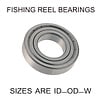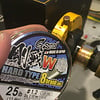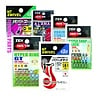Split cane, tanekaha and bamboo were once the buzz words for early fishing rod manufacture. Then entered solid fibreglass. They were made by a process called pultrusion, a method used to make electric fence standards. The parallel blanks were then ground to a taper, ending up short and stiff. Heavy wooden butts and chrome ferrules ensured you fought your rod, as well as the fish.
Hollow fibreglass blanks followed. That decreased the weight and, being formed on tapered mandrels, lead to the ability to tune the blanks to different applications. Grips were now Hypalon, cutting the weight down more, and then the first ceramic guides showed up.
Jump forward to today and carbon/graphite is king: lighter and more responsive. Not as strong as fibreglass, but when used in conjunction with fibreglass you've got a light, strong rod. We have some carbon/glass rods that are capable of picking up 29kg off the ground.
I grabbed three old rods that were lying around (all about the same length). First, a split cane rod. It weighed in at 345g. An early fibreglass rod punched the scales at 500g, and the modern carbon rod a diminutive 80g -- a contender for the featherweight division.
Using carbon blanks, lightweight EVA grips, and less glue, makes them about as light as we can get without sacrificing strength. The way the carbon is woven also increases response and feel: cross weave, vnet, twill weave... Sounds like knitting, and that just what it is. Add new UV-resistant finishes, and silicone carbide and titanium guides, and the chap who built the old cane rod wouldn't believe his eyes.
I wonder if the 80g carbon rod will still be around in fifty years time? I doubt it. I bet it will have exploded in a moment of inattention. Perhaps I should add it to my timeline museum of tackle. It deserves its place next to its ancestors.
Search results for ""
Filters


 Fishing reel bearings
Fishing reel bearings
 Fishing line - Braid
Fishing line - Braid
 Fishing tackle
Fishing tackle
 Rods & reels
Rods & reels
 Hot deals
Hot deals
 Blog
Blog









